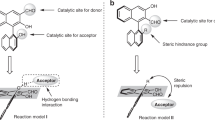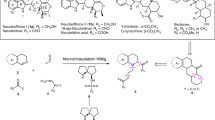Abstract
Catalytic reactions that enable access to different diastereoisomers are important but often difficult to achieve. One long-standing unsolved challenge is the anti-selective conjugate addition reaction between aldehydes and nitroolefins. This organocatalytic transformation is a versatile method for the synthesis of γ-nitroaldehydes and downstream compounds such as pyrrolidines and γ-butyrolactams, which are key moieties in bioactive molecules. Numerous amine catalysts have been developed for this transformation, but all provide syn-configured products. Here, we present a tripeptide as a general catalyst for the synthesis of anti-configured γ-nitroaldehydes. Key to the anti selectivity is the installation of substituents at Cδ of the reactive pyrrolidine of proline to enable the formation of s-cis enamine intermediates. The peptidic catalyst converts different aldehyde and nitroolefin combinations into the products in high yields and stereoselectivities. Conformational and mechanistic studies revealed a Curtin–Hammett scenario for the catalytic system. The strategy provides long-sought-after access to anti-configured γ-nitroaldehydes and a guide for reversing the diastereoselectivity of amine-based organocatalysts.




Similar content being viewed by others
Data availability
The authors declare that all data supporting the findings of this study are available within the manuscript and its Supplementary information.
References
Mukherjee, S., Yang, J. W., Hoffmann, S. & List, B. Asymmetric enamine catalysis. Chem. Rev. 107, 5471–5569 (2007).
Alonso, D. A. et al. Recent advances in asymmetric organocatalyzed conjugate additions to nitroalkenes. Molecules 22, 895–945 (2017).
van der Helm, M. P., Klemm, B. & Eelkema, R. Organocatalysis in aqueous media. Nat. Rev. Chem. 3, 491–508 (2019).
Vitaku, E., Smith, D. T. & Njardarson, J. T. Analysis of the structural diversity, substitution patterns, and frequency of nitrogen heterocycles among U.S. FDA approved pharmaceuticals. J. Med. Chem. 57, 10257–10274 (2014).
Hayashi, Y., Gotoh, H., Hayashi, T. & Shoji, M. Diphenylprolinol silyl ethers as efficient organocatalysts for the asymmetric Michael reaction of aldehydes and nitroalkenes. Angew. Chem. Int. Ed. 44, 4212–4215 (2005).
Lalonde, M. P., Chen, Y. & Jacobsen, E. N. A chiral primary amine thiourea catalyst for the highly enantioselective direct conjugate addition of α,α-disubstituted aldehydes to nitroalkenes. Angew. Chem. Int. Ed. 45, 6366–6370 (2006).
Palomo, C., Vera, S., Mielgo, A. & Gómez-Bengoa, E. Highly efficient asymmetric Michael addition of aldehydes to nitroalkenes catalyzed by a simple trans-4-hydroxyprolylamide. Angew. Chem. Int. Ed. 45, 5984–5987 (2006).
García-García, P., Ladépêche, A., Halder, R. & List, B. Catalytic asymmetric Michael reactions of acetaldehyde. Angew. Chem. Int. Ed. 47, 4719–4721 (2008).
Zhu, S., Yu, S. & Ma, D. Highly efficient catalytic system for enantioselective Michael addition of aldehydes to nitroalkenes in water. Angew. Chem. Int. Ed. 47, 545–548 (2008).
Wiesner, M., Revell, J. D. & Wennemers, H. Tripeptides as efficient asymmetric catalysts for 1,4-addition reactions of aldehydes to nitroolefins–a rational approach. Angew. Chem. Int. Ed. 47, 1871–1874 (2008).
Wiesner, M., Neuburger, M. & Wennemers, H. Tripeptides of the type H-D-Pro-Pro-Xaa-NH2 as catalysts for asymmetric 1,4-addition reactions: structural requirements for high catalytic efficiency. Chem. Eur. J. 15, 10103–10109 (2009).
Seebach, D. & Goliński, J. Synthesis of open-chain 2,3-disubstituted 4-nitroketones by diastereoselective Michael-addition of (E)-enamines to (E)-nitroolefins. A topological rule for C,C-bond forming processes between prochiral centres. Preliminary communication. Helv. Chim. Acta 64, 1413–1423 (1981).
Seebach, D., Beck, A. K., Goliński, J., Hay, J. N. & Laube, T. Über den sterischen verlauf der umsetzung von enaminen aus offenkettigen aldehyden und ketonen mit nitroolefinen zu 2,3-disubstituierten 4-nitroketonen. Helv. Chim. Acta 68, 162–172 (1985).
Husch, T., Seebach, D., Beck, A. K. & Reiher, M. Rigorous conformational analysis of pyrrolidine enamines with relevance to organocatalysis. Helv. Chim. Acta 100, e1700182 (2017).
Földes, T. et al. Stereocontrol in diphenylprolinol silyl ether catalyzed Michael additions: steric shielding or Curtin–Hammett scenario? J. Am. Chem. Soc. 139, 17052–17063 (2017).
Zhu, S., Yu, S., Wang, Y. & Ma, D. Organocatalytic Michael addition of aldehydes to protected 2-amino-1-nitroethenes: the practical syntheses of oseltamivir (Tamiflu) and substituted 3-aminopyrrolidines. Angew. Chem. Int. Ed. 49, 4656–4660 (2010).
Uehara, H. & Barbas, C. anti-Selective asymmetric Michael reactions of aldehydes and nitroolefins catalyzed by a primary amine/thiourea. Angew. Chem. Int. Ed. 48, 9848–9852 (2009).
Kano, T., Sugimoto, H., Tokuda, O. & Maruoka, K. Unusual anti-selective asymmetric conjugate addition of aldehydes to nitroalkenes catalyzed by a biphenyl-based chiral secondary amine. Chem. Commun. 49, 7028–7030 (2013).
Macharia, J. et al. A designed approach to enantiodivergent enamine catalysis. Angew. Chem. Int. Ed. 56, 8756–8760 (2017).
Duschmalé, J. & Wennemers, H. Adapting to substrate challenges: peptides as catalysts for conjugate addition reactions of aldehydes to α,β-disubstituted nitroolefins. Chem. Eur. J. 18, 1111–1120 (2012).
Kastl, R. & Wennemers, H. Peptide-catalyzed stereoselective conjugate addition reactions generating all-carbon quaternary stereogenic centers. Angew. Chem. Int. Ed. 52, 7228–7232 (2013).
Krattiger, P., Kovasy, R., Revell, J. D., Ivan, S. & Wennemers, H. Increased structural complexity leads to higher activity: peptides as efficient and versatile catalysts for asymmetric aldol reactions. Org. Lett. 7, 1101–1103 (2005).
Grünenfelder, C. E., Kisunzu, J. K. & Wennemers, H. Peptide-catalyzed stereoselective conjugate addition reactions of aldehydes to maleimide. Angew. Chem. Int. Ed. 55, 8571–8574 (2016).
Schnitzer, T. & Wennemers, H. Influence of the trans/cis conformer ratio on the stereoselectivity of peptidic catalysts. J. Am. Chem. Soc. 139, 15356–15362 (2017).
Wiesner, M., Upert, G., Angelici, G. & Wennemers, H. Enamine catalysis with low catalyst loadings - high efficiency via kinetic studies. J. Am. Chem. Soc. 132, 6–7 (2010).
Bächle, F., Duschmalé, J., Ebner, C., Pfaltz, A. & Wennemers, H. Organocatalytic asymmetric conjugate addition of aldehydes to nitroolefins: identification of catalytic intermediates and the stereoselectivity-determining step by ESI-MS. Angew. Chem. Int. Ed. 52, 12619–12623 (2013).
Duschmalé, J., Wiest, J., Wiesner, M. & Wennemers, H. Effects of internal and external carboxylic acids on the reaction pathway of organocatalytic 1,4-addition reactions between aldehydes and nitroolefins. Chem. Sci. 4, 1312–1318 (2013).
Rigling, C. et al. Conformational properties of a peptidic catalyst: insights from NMR spectroscopic studies. J. Am. Chem. Soc. 140, 10829–10838 (2018).
Schnitzer, T., Wiesner, M., Krattiger, P., Revell, J. D. & Wennemers, H. Is more better? A comparison of tri- and tetrapeptidic catalysts. Org. Biomol. Chem. 15, 5877–5881 (2017).
Schnitzer, T. & Wennemers, H. Effect of γ-substituted proline derivatives on the performance of the peptidic catalyst H-dPro-Pro-Glu-NH2. Synthesis 50, 4377–4382 (2018).
Harder, E. et al. OPLS3: a force field providing broad coverage of drug-like small molecules and proteins. J. Chem. Theory Comput. 12, 281–296 (2016).
Still, W. C., Tempczyk, A., Hawley, R. C. & Hendrickson, T. Semianalytical treatment of solvation for molecular mechanics and dynamics. J. Am. Chem. Soc. 112, 6127–6129 (1990).
Grimme, S., Antony, J., Ehrlich, S. & Krieg, H. A consistent and accurate ab initio parametrization of density functional dispersion correction (DFT-D) for the 94 elements H-Pu. J. Chem. Phys. 132, 154104 (2010).
Grimme, S., Ehrlich, S. & Goerigk, L. Effect of the damping function in dispersion corrected density functional theory. J. Comput. Chem. 32, 1456–1465 (2011).
Zhao, Y. & Truhlar, D. G. The M06 suite of density functionals for main group thermochemistry, thermochemical kinetics, noncovalent interactions, excited states, and transition elements: two new functionals and systematic testing of four M06-class functionals and 12 other functionals. Theor. Chem. Acc. 120, 215–241 (2008).
Krishnan, R., Binkley, J. S., Seeger, R. & Pople, J. A. Self-consistent molecular orbital methods. XX. A basis set for correlated wave functions. J. Chem. Phys. 72, 650–654 (1980).
McLean, A. D. & Chandler, G. S. Contracted Gaussian basis sets for molecular calculations. I. Second row atoms, Z=11–18. J. Chem. Phys. 72, 5639–5648 (1980).
Schmid, M. B., Zeitler, K. & Gschwind, R. M. Distinct conformational preferences of prolinol and prolinol ether enamines in solution revealed by NMR. Chem. Sci. 2, 1793–1803 (2011).
Haindl, M. H., Hioe, J. & Gschwind, R. M. The proline enamine formation pathway revisited in dimethyl sulfoxide: rate constants determined via NMR. J. Am. Chem. Soc. 137, 12835–12842 (2015).
Schmid, M. B., Zeitler, K. & Gschwind, R. M. Formation and stability of prolinol and prolinol ether enamines by NMR: delicate selectivity and reactivity balances and parasitic equilibria. J. Am. Chem. Soc. 133, 7065–7074 (2011).
Metrano, A. J. & Miller, S. J. Peptide-based catalysts reach the outer sphere through remote desymmetrization and atroposelectivity. Acc. Chem. Res. 52, 199–215 (2019).
Colby Davie, E. A., Mennen, S. M., Xu, Y. & Miller, S. J. Asymmetric catalysis mediated by synthetic peptides. Chem. Rev. 107, 5759–5812 (2007).
Lewandowski, B. & Wennemers, H. Asymmetric catalysis with short-chain peptides. Curr. Opin. Chem. Biol. 22, 40–46 (2014).
Acknowledgements
We thank the Fonds der Chemischen Industrie (Germany) for a Kekulé Fellowship for T.S., the Alfred Werner Fund of the Swiss Chemical Society Foundation for an MSc scholarship for A.B. and the Swiss National Science Foundation (grant no. 200020_169423).
Author information
Authors and Affiliations
Contributions
T.S. and A.B. conducted the experiments. T.S. and H.W. conceived and designed the project, analysed the data and prepared this manuscript.
Corresponding author
Ethics declarations
Competing interests
The authors declare no competing interests.
Additional information
Publisher’s note Springer Nature remains neutral with regard to jurisdictional claims in published maps and institutional affiliations.
Supplementary information
Supplementary Information
Supplementary methods, Tables 1–5, Figs. 1 and 2 and references.
Supplementary Data 1
Coordinates of the calculated lowest-energy structures.
Rights and permissions
About this article
Cite this article
Schnitzer, T., Budinská, A. & Wennemers, H. Organocatalysed conjugate addition reactions of aldehydes to nitroolefins with anti selectivity. Nat Catal 3, 143–147 (2020). https://doi.org/10.1038/s41929-019-0406-4
Received:
Accepted:
Published:
Issue Date:
DOI: https://doi.org/10.1038/s41929-019-0406-4
- Springer Nature Limited
This article is cited by
-
Generation of new carbon–carbon and carbon–heteroatom bonds mediated by agro-waste extracts: a review
Environmental Chemistry Letters (2022)





